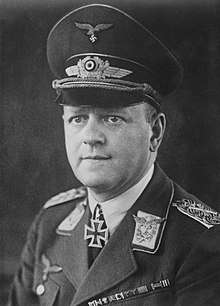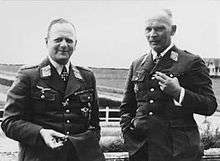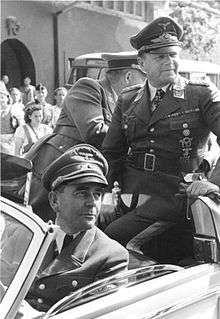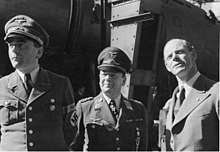Erhard Milch
Erhard Milch (30 March 1892 – 25 January 1972) was a German field marshal who oversaw the development of the Luftwaffe as part of the re-armament of Nazi Germany following World War I. During World War II, he was in charge of aircraft production. He was convicted of war crimes during the Milch Trial held before the U.S. military court in 1947 and sentenced to life imprisonment; he was released in 1954.
Erhard Milch | |
|---|---|
 Milch in March 1942 | |
| Born | 30 March 1892 Wilhelmshaven, Grand Duchy of Oldenburg, German Empire |
| Died | 25 January 1972 (aged 79) Düsseldorf, North Rhine-Westphalia, West Germany |
| Allegiance | |
| Branch | Luftwaffe |
| Years of service | 1910–22 1933–45 |
| Rank | Generalfeldmarschall |
| Commands held | Jägerstab ("Fighter Staff" task force) |
| Battles/wars | World War I
|
| Awards | Knight's Cross of the Iron Cross |
| Relations | Werner Milch (brother) |
Descendance and early life
Milch was born in Wilhelmshaven, the son of Anton Milch, a Jewish pharmacist[1] who served in the Imperial German Navy, and Clara Milch, née Vetter. The Gestapo would later investigate Milch due to his Jewish heritage. In 1935 rumours began to circulate that his father was a Jew. The Gestapo began an investigation that was halted by Hermann Göring, the Luftwaffe commander-in-chief, who produced an affidavit by Milch's mother that his true father was her uncle Karl Brauer. Milch was then issued with a German Blood Certificate.[2] This would mean that his mother Clara admitted not only to adultery but also incest. David Irving in his book The Rise and Fall of the Luftwaffe. The Life of Field Marshal Erhard Milch, says that Milch asked him not to reveal the real truth about his parentage, so although Irving states that it was not Anton Milch and concentrates on his wealthy great-uncle Karl Brauer who died in 1906, he does not actually name him as his father.[3] However, Irving, who had access to the Field Marshal's private diary and papers, says the rumours began in the autumn of 1933, and that Erhard personally obtained a signed statement by Anton Milch that he was not the father of Clara's children. Furthermore, Irving says that Clara Milch had already written to her son in law Fritz Herrmann in March 1933 explaining the circumstances of her marriage and that Göring had initiated his own investigation that identified his real father. Milch was again questioned about his alleged Jewish father and Göring's role in this matter by Robert H. Jackson at Nuremberg in 1946.[4]
World War I and inter-war career
Milch enlisted in the German Army in 1910, where he rose to the rank of lieutenant and commanded an artillery unit in East Prussia on the outbreak of WW1. He saw action against the Russian Army on the River Deime in September 1914 and later on the Angerapp Line in February 1915. In July 1915, he was transferred to the Luftstreitkräfte (Imperial Air Force) and trained as an aerial observer on the Western front, seeing action on the Somme 1916 and later in Flanders 1917. After a spell as a company commander in the trenches in the spring and summer of 1918, in the waning days of the war, he was promoted to captain and appointed to command a fighter wing, Jagdgruppe 6, even though he had never trained as a pilot and could not fly himself.[5]
Milch resigned from the military in 1920 to pursue a career in civil aviation. With squadron colleague Gotthard Sachsenberg, Milch formed a small airline in Danzig under the banner of Lloyd Luftdienst, Norddeutscher Lloyd's union of regional German airlines. The airline linked Danzig to the Baltic States. In 1923, Milch became the managing director of its successor company. From there, Milch and Sachsenberg went to work for rival Junkers Luftverkehr, where Milch was appointed a managing director in 1925. In 1926, Milch was named a managing director (one of three) of the newly-formed airline Deutsche Luft Hansa.[6][7] Milch joined the Nazi Party (number 123885) on 1 April 1929, but his membership was not officially acknowledged until March 1933, because Hitler deemed it desirable to keep the fact hidden for political reasons.[8][9]

In 1933, Milch took up a position as State Secretary of the newly formed Reich Ministry of Aviation (RLM), answering directly to Hermann Göring. In this capacity, he was instrumental in establishing the Luftwaffe, the air force of Nazi Germany. Milch was responsible for armament production, though Ernst Udet was soon making many of the decisions concerning contracts for military aircraft. Milch quickly used his position to settle personal scores with other aviation industry personalities, including Hugo Junkers and Willy Messerschmitt. Specifically, Milch banned Messerschmitt from submitting a design in the competition for a new fighter aircraft for the Luftwaffe. Messerschmitt outmanoeuvred Milch, circumventing the ban and successfully submitting a design. The Messerschmitt-designed Bayerische Flugzeugwerke corporate entry, the Bf 109, proved to be the winner. Messerschmitt maintained its leading position within the German aircraft industry until the failure of the Me 210 aircraft. Even after that Milch, as the leader, did not depose him, but put him in an inferior position.[10]
In 1935 doubts about the ethnic origin of Erhard Milch began when rumors circulated that his father Anton Milch was Jewish. The Gestapo began an investigation but it was stopped by Göring who forced Erhard's mother to sign a document that Anton was not the true father of Erhard and his brothers, but her uncle Karl Brauer. Those events and the later extension of the "Certificate of German Blood" were the background to Göring's statement, "I decide who is a Jew in the airforce". However, many believe that he was merely quoting Karl Lueger, the former mayor of Vienna.
World War II

At the outbreak of World War II Milch, now with the rank of general, commanded Luftflotte 5 during the Operation Weserübung in Norway. Following the defeat of France, Milch was promoted to Generalfeldmarschall (field marshal) during the 1940 Field Marshal Ceremony and given the title Air Inspector General. As such, Milch was in charge of aircraft production.[11] Milch cancelled production of the ineffective and dangerous Me 210 and He 177 and put them back in development. Under his direction, aircraft production focused on mass production of the tested and tried models. Production level doubled in the summer of 1943 in comparison with the winter of 1941–1942. Tooze comments: "For the first time, the German aircraft industry was able to achieve substantial economies of scale. The resources pumped into the Luftwaffe in 1940–41 were now concentrated in mass assembly."[12] To achieve this level of mass production, the Armaments Ministries and the industry cooperated with the SS to procure labour from the concentration camps. Due to Milch's connections with the SS, the Luftwaffe had an advantage in obtaining slave labour.[12]. In order to increase the quantity, Milch also made some sacrifices in quality, notable in the case of the Bf 109. When the US Air Force began to directly challenge the fighter forces of the Luftwaffe, the cost of Milch's decisions was shown. Especially, the handling of the Bf 109 G was so bad that it became, in the words of Tooze, "little more than death traps".[13]
The frequent, and often conflicting, changes in operational requirements led to numerous changes in aircraft specification and designs so that manufacturers like Messerschmitt were unable to focus outright on a few aircraft types and, most importantly, production output. The Germans failed to put their production on a war footing, continued to run factories only eight hours a day, and failed to include women in the workforce. German World War II aircraft production output did not rise as steeply as Allied output, especially Soviet production, which exceeded Germany's in 1942 and 1943.

On 10 August 1943, Milch finally addressed Germany's lack of a truly "four-engined" heavy bomber to carry out raids against Great Britain. He endorsed Arado Flugzeugwerke to be the subcontractor for the Heinkel He 177B separately engined heavy bomber design. Only three flyable prototypes were completed by early 1944.[14] From March 1944, Milch, together with Albert Speer, oversaw the activities of the Jägerstab ("Fighter Staff"), a governmental task force whose aim was to increase the production of fighter aircraft, in part by moving the production facilities underground. In cooperation with the SS, the task force played a key role in the exploitation of slave labour for the benefit of the German aircraft industry and the Luftwaffe.[15]
In 1944 Milch sided with Joseph Goebbels, the propaganda minister and Heinrich Himmler, the Reichsführer-SS, in attempting to convince Adolf Hitler to remove Göring from command of the Luftwaffe. When Hitler refused, Göring retaliated by forcing Milch out of his position. For the rest of the war, he worked under Albert Speer.
Following Hitler’s suicide, Milch attempted to flee Germany but was apprehended by Allied forces on the Baltic coast on 4 May 1945. On surrendering, he presented his baton to British Brigadier Derek Mills-Roberts, who was so disgusted and angered by the atrocities he had seen committed when liberating the Bergen-Belsen concentration camp that he brutally broke the baton over Milch's head with several blows and repeatedly beat Milch with a champagne bottle. This incident left Milch with several contusions and a fractured skull.[16]
Trial and conviction at Nuremberg
-2.jpg)
Milch was intended by the Allies to be a witness for the prosecution at Nuremberg but after seeing the conditions in which the defendants were held changed his mind and refused to cooperate. He was then tried as a war criminal in 1947 by a United States Military Tribunal in Nuremberg. He was convicted on two counts:
- War crimes, by participating in the ill-treatment and use of the forced labour of prisoners of war (POWs) and the deportation of civilians to the same ends.
- Crimes against humanity, by participating in the murder, extermination, enslavement, deportation, imprisonment, torture, and the use of slave labour of civilians who came under German control, German nationals and prisoners of war.
Milch was sentenced to life imprisonment at Landsberg prison. His sentence was commuted to 15 years imprisonment in 1951, but he was released in June 1954. He lived out the remainder of his life in Düsseldorf, where he died in 1972.
Awards
- Knight's Cross of the Iron Cross on 4 May 1940 as Generaloberst and chief of Luftflotte 5 and Befehlshaber Nord (commander-in-chief north).[17]
See also
- Self hating Jew
- Who is a Jew?
References
Citations
- Bunyan, Anita (21 March 2003). "Half-shadows of the Reich". Times Higher Education. A review of Rigg 2002.
- P. Kaplan, Fighter Aces of the RAF in the Battle of Britain, p132.
- The Rise and Fall of the Luftwaffe. The Life of Field Marshal Erhard Milch p.VII & p2-3
- Irving p340.
- Franks, Bailey & Guest 1993, p. 32, Irving Milch p7-10.
- Suchenwirth, Prof Richard (11 July 2017). Command and Leadership in the German Air Force. Pickle Partners Publishing. ISBN 9781787206755.
- "Erhard Milch, 79, Luftwaffe Chief". The New York Times. 29 January 1972. ISSN 0362-4331. Retrieved 10 August 2019.
- Boog 1994, p. 499–503.
- Angolia 1976, p. 351–7.
- Tooze, A. (2007). The Wages of Destruction: The Making and Breaking of the Nazi Economy. New York: Viking. ISBN 978-0670038268.
- "Erhard Milch". HistoryLearningSite.co.uk. 2014.
- Tooze 2007, p. 715.
- Tooze 2007, p. 584.
- Griehl & Dressel 1998, p. 162.
- Buggeln 2004, p. 46.
- Neillands, Robin; Normann, Roderick de (1993). D-Day 1944 – voices from Normandy. New York: Cold Spring Press. ISBN 1593600127.
- Scherzer 2007, p. 545.
Bibliography
- Angolia, John R. (1976). For Führer and Fatherland: Military Awards of the Third Reich. R. James Bender. pp. 351–7. ISBN 978-0912138145.CS1 maint: ref=harv (link)
- Boog, Horst (1994). Milch, Erhard. Neue Deutsche Biographie (in German). 17. pp. 499–503.CS1 maint: ref=harv (link)
- Buggeln, Marc (2014). Slave Labor in Nazi Concentration Camps. Oxford University Press. ISBN 9780198707974.CS1 maint: ref=harv (link)
- Franks, Norman L. R.; Bailey, Frank W.; Guest, Russell (1993). Above the Lines: The Aces and Fighter Units of the German Air Service, Naval Air Service and Flanders Marine Corps, 1914–1918. London: Grub Street. ISBN 0948817739.CS1 maint: ref=harv (link)
- Griehl, Manfred; Dressel, Joachim (1998). Heinkel He 177-277-274. Shrewsbury, UK: Airlife Publishing. ISBN 1-85310-364-0.CS1 maint: ref=harv (link)
- Rigg, Bryan Mark (2002). Hitler's Jewish Soldiers: The Untold Story of Nazi Racial Laws and Men of Jewish Descent in the German Military. Lawrence: University Press of Kansas. ISBN 978-0700613588.CS1 maint: ref=harv (link)
- Scherzer, Veit (2007). Die Ritterkreuzträger 1939–1945 Die Inhaber des Ritterkreuzes des Eisernen Kreuzes 1939 von Heer, Luftwaffe, Kriegsmarine, Waffen-SS, Volkssturm sowie mit Deutschland verbündeter Streitkräfte nach den Unterlagen des Bundesarchives [The Knight's Cross Bearers 1939–1945 The Holders of the Knight's Cross of the Iron Cross 1939 by Army, Air Force, Navy, Waffen-SS, Volkssturm and Allied Forces with Germany According to the Documents of the Federal Archives] (in German). Jena, Germany: Scherzers Militaer-Verlag. ISBN 978-3-938845-17-2.
External links
| Military offices | ||
|---|---|---|
| Preceded by none |
Commander of Luftflotte 5 12 April 1940 – 10 May 1940 |
Succeeded by Generaloberst Hans-Jürgen Stumpff |